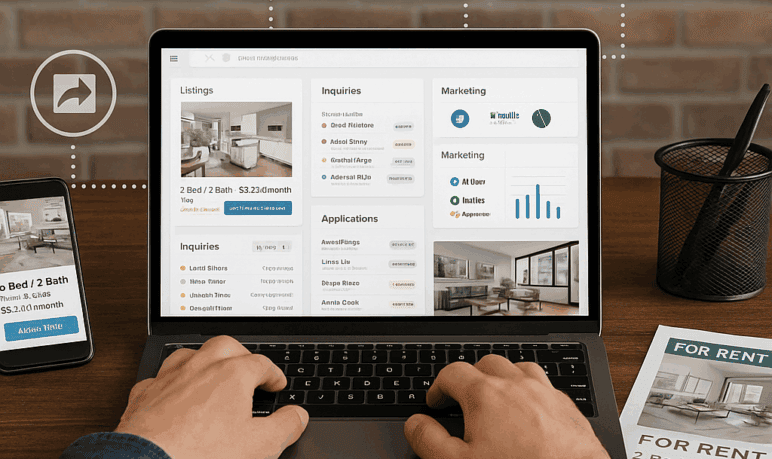
by Inez Kim August 7, 2025
The rental housing industry has evolved rapidly in the past few years, driven by changing tenant expectations and a shift toward digital convenience. As renters now expect fast responses, mobile-friendly listings, and seamless application processes, property managers are under pressure to keep up. This is where integrating property management software with digital marketing tools becomes not just helpful but necessary.
Rental businesses, whether managing a handful of units or hundreds, need effective systems to handle listing distribution, lead capture, tenant screening, and communication. Doing all this manually is not only time-consuming but also prone to costly errors and missed opportunities. Thankfully, modern rental property marketing software is designed to make this process efficient, consistent, and scalable.

Online Listing Syndication for Maximum Visibility
A major challenge for property managers is ensuring their listings reach the right audience. Most renters begin their search online, often browsing multiple platforms like Zillow, Apartments.com, Rent.com, and Craigslist. Manually posting to each site takes time, creates room for inconsistencies, and often delays the listing process.
One-Click Syndication and Broader Reach
One of the biggest advantages of rental property marketing software is the ability to syndicate listings across multiple platforms in one click. With this feature, property managers can create a listing once and publish it to dozens of rental websites simultaneously. This improves consistency, saves time, and ensures faster exposure of the vacancy.
Professional Listings with Built-In Application Tools
These platforms also help enhance the quality of the listings. Instead of plain text ads, property managers can create visually appealing listing pages with high-resolution photos, descriptions, location maps, and clearly stated rental criteria. Many software options include built-in application buttons so prospects can apply directly from the listing. These professional pages reflect well on the property and attract higher-quality leads.
Lead Tracking and CRM Tools That Centralize Inquiries
Once listings are live, the next challenge is managing incoming interest. Prospective tenants may inquire via listing sites, your own website, social media, or referrals. Without a system in place, these leads can easily get lost in email inboxes or overlooked in call logs.
Centralized Dashboard for Inbound Inquiries
Modern lead tracking for property managers is often handled through an integrated CRM system within the property management software. All inquiries—regardless of where they originate—are captured and displayed in a single dashboard. This allows property managers to quickly view, respond to, and track the status of each lead.
Status Updates and Automated Follow-Ups
These systems allow for tagging leads by stage, such as “New Inquiry,” “Showing Scheduled,” or “Application Submitted.” Managers can then automate follow-ups like sending reminders before scheduled showings or responding instantly to new leads with auto-generated texts or emails. This kind of organization prevents hot leads from going cold and improves the chances of converting interest into occupancy.
Streamlining the Tenant Application Pipeline
Once a lead shows interest and is ready to apply, the next phase of the journey begins. In a manual process, this could involve paperwork, printing forms, scanning IDs, and many back-and-forth emails. However, most tenant leads management tools within rental software aim to eliminate these inefficiencies.
Mobile-Friendly Applications and Self-Tours
With integrated application tools, renters can apply online from their phone, tablet, or computer. These applications are automatically fed into the system, pre-filled with the listing information. Some advanced platforms also allow renters to schedule self-guided tours using a secure app, further reducing friction in the leasing process.
Screening and Conversion Made Easy
Once the application is submitted, the property manager can initiate background and credit checks using integrated screening tools. If approved, the software can immediately convert the lead into a tenant profile, carrying forward application data into the lease agreement and resident portal. This seamless pipeline reduces paperwork and creates a more pleasant experience for both the manager and the renter.

Integrating with Broader Digital Marketing Channels
While software takes care of operational efficiency, visibility is still key. Advanced users can take advantage of digital integrations that enhance digital marketing for rentals and track campaign performance.
Website Plugins and Social Media Sharing
Many platforms allow embedding rental listings directly onto the property manager’s website via plugins or widgets. This ensures listings stay updated in real time without having to manually edit the site. In addition, property managers can share listings directly to social media platforms like Facebook Marketplace or Instagram, leveraging organic reach and engagement.
Campaign Tracking and Analytics Integration
Some rental software tools offer integration with Google Ads, Google Analytics, or UTM tracking systems. This means you can track exactly where your leads are coming from—be it paid ads, organic search, or social referrals. With this information, marketing teams can assess which campaigns or channels are most effective and refine their strategies accordingly.
Automated Communication for Better Engagement
Tenant communication is one of the most time-consuming parts of rental management. Whether it’s answering common questions or scheduling multiple appointments, delays can result in lost leads.
Smart Templates and Scheduled Messaging
Automated communication tools within rental property marketing software allow managers to create reusable templates for frequent questions such as “Is this unit pet-friendly?” or “What’s the security deposit?” These templates ensure consistency and save time.
Messages can also be scheduled in advance, such as appointment reminders or rent promotions. Sending a bulk email or SMS campaign to a group of prospects about an upcoming open house can increase attendance without requiring hours of manual outreach.
Personalized Yet Scalable Interactions
Despite being automated, these systems are designed to feel personal. Dynamic tags in messages can insert the prospect’s name, the unit they’re interested in, and even custom links for application or scheduling. This creates the impression of personal service while still being scalable.
Managing Reputation and Generating Referrals
Marketing doesn’t stop once a lease is signed. Happy tenants are one of the most powerful tools for filling future vacancies. A strong online reputation and effective tenant leads management strategy can bring in a steady stream of referred or repeat renters.
Gathering Feedback and Showcasing Testimonials
While not all property software includes review management, some allow you to send surveys or feedback forms to tenants. This feedback can be used internally for improvement or externally as testimonials on your website or listings. Encouraging tenants to leave reviews on platforms like Google, Yelp, or Facebook can significantly boost credibility with future renters.
Turning Satisfied Tenants into Promoters
Even if the software doesn’t directly handle review aggregation, it can support email campaigns that ask satisfied renters to share their experience or refer a friend. These subtle efforts, when automated and tracked, help create a positive feedback loop that supports long-term growth.
Measuring Marketing ROI with Reporting Tools
The final, and arguably most critical, aspect of any rental marketing strategy is performance tracking. It’s not enough to just list a property and hope it fills. Property managers need to understand what’s working and what’s not.
Traffic, Conversion, and Source Reporting
Good rental property marketing software includes reporting dashboards that show metrics like listing views, number of inquiries, lead-to-application conversion rate, and cost per lead. If one listing site is consistently generating quality applications while another draws few clicks, the marketing budget can be reallocated accordingly.
Optimizing Strategies Based on Data
Managers can compare seasonal trends, test different photos or headlines, and see how small tweaks impact performance. Over time, this data allows them to fine-tune their marketing mix, save on acquisition costs, and reduce vacancy periods. With more precise control over their rental listing syndication strategy, they can scale effectively.
The Future of Marketing and Lead Management in Rentals
As the rental industry becomes more digital and competitive, relying on spreadsheets, inboxes, and manual effort is no longer sustainable. Renters expect a streamlined experience, and property managers need tools that can deliver it efficiently. Integrating property management software with digital marketing tools creates a powerful system that attracts, manages, and converts leads with far less effort.
By embracing automation, centralization, and data insights, rental businesses position themselves to grow sustainably while delivering the kind of experience today’s renters demand. Whether it’s through more effective lead tracking for property managers or better use of digital marketing for rentals, these tools aren’t just nice to have—they’re the future of smart property management.
Frequently Asked Questions
What is rental property marketing software and how does it help landlords?
Rental property marketing software is a digital tool that helps landlords and property managers promote vacant units, manage leads, and streamline communication with prospects. It enables users to create professional listings, syndicate them across rental sites, track inquiries, automate follow-ups, and collect applications—all from a single platform. This leads to faster leasing and improved operational efficiency.
How does lead tracking for property managers improve occupancy rates?
Lead tracking for property managers ensures that all inquiries from different channels—such as listing sites, websites, or social media—are captured in one place. This centralized system allows managers to monitor each lead’s journey, send timely reminders, and follow up efficiently. By reducing the chances of missed communication, it increases the likelihood of converting prospects into tenants.
Can rental listing syndication really save time?
Yes. Rental listing syndication allows property managers to publish a single listing across multiple rental platforms with one click. Instead of manually entering the same information into each site, syndication ensures broader exposure with minimal effort. It also maintains consistency across platforms, which improves the listing’s credibility and reach.
How does digital marketing for rentals work with property management software?
Digital marketing for rentals is enhanced when integrated with property management software. Users can share listings on social platforms, embed them into websites, run paid campaigns, and track which channels generate the most leads. Software integrations with Google Ads or analytics tools also provide insight into marketing ROI, helping optimize future campaigns for better results.